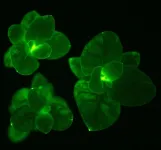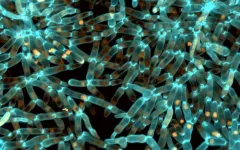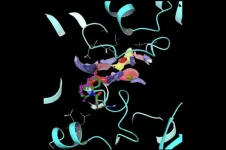(Press-News.org) Reston, VA—A new PET radiotracer can differentiate diseased tissues from healthy tissues based on fructose metabolism, according to new research published in the March issue of The Journal of Nuclear Medicine. Fructose metabolism—or fructolysis—is indicative of a variety of diseases, and by noninvasively mapping fructolysis physicians can more accurately detect diseases and treat them earlier.
Glucose is used as the primary biochemical fuel throughout the body, powering key processes like tissue function, growth, and repair. Glucose is also consumed extensively during inflammation and cancer growth and can be visualized with PET scans. Evidence continues to mount that disease processes can force cells to use alternative fuels, like fructose, to power the progression of various diseases, yet an accurate PET imaging dye to measure fructose metabolism is not currently available.
“The fundamental importance of fructolysis in metabolic, neurodegenerative, and cardiac disorders, as well as cancer, has encouraged the development of methods to noninvasively map fructose metabolism.,” stated Adam Shuhendler, PhD, associate professor and Canada Research Chair at the University of Ottawa, and scientist at the University of Ottawa Heart Institute in Ottawa, Canada. “Our work focused on this diagnostic opportunity and revisited the design of an imaging dye capable of mapping fructose use with high reliability.”
Previous approaches to fructose dye generation resulted in the non-specific accumulation of the PET imaging signal in bone tissue. In this study, researchers used the fructose metabolic pathway to inform where to modify fructose with an imaging label and created a new dye known as [18F]-4-fluorodeoxyfructose (4FDF). 4FDF resulted in the successful trapping of the labelled fructose in disease tissues and not in the bone.
With this new fructose-based imaging dye, researchers compared 4FDF to the clinical standard for glucose mapping, FDG, in a mouse model. Like FDG, 4FDF accumulated in tumor tissue, but unlike FDG, it did not accumulate in healthy brain or healthy heart, two organs with very high FDG uptake. When inflammation was induced in the brain and heart, both organs showed strong 4FDF signals. Bone uptake was minimized with 4FDF, further supporting the need for specific mapping of tissues that have undergone the glucose-to-fructose fuel switch that is a signature of heart and brain diseases.
“For the first time, fructose metabolism can be mapped sensitively with PET imaging, with the potential to open new applications for imaging-based diagnoses not possible with FDG,” said Shuhendler. “By widening the gap between the amount of 4FDF retained in healthy versus diseased heart and brain, disease of these organs can be more sensitively detected. The scope of precisely which diseases is still currently under investigation, but could include stroke, brain metastases, and heart attacks.”
This article was published online in January 2024.
The authors of “It’s a Trap! Aldolase-Prescribed C4 Deoxyradiofluorination Affords Intracellular Trapping and the Tracing of Fructose Metabolism by PET” include Alexia Kirby, Department of Biology, University of Ottawa, Ottawa, Ontario, Canada, and Heart Institute, University of Ottawa, Ottawa, Ontario, Canada; Dominic Graf, Mojmír Suchý, and Nicholas D. Calvert, Heart Institute, University of Ottawa, Ottawa, Ontario, Canada, and Department of Chemistry and Biomolecular Sciences, University of Ottawa, Ottawa, Ontario, Canada; Thomas A. Charlton and Robert N. Ben, Heart Institute, University of Ottawa, Ottawa, Ontario, Canada; Christina L. Addison, Program for Cancer Therapeutics, Ottawa Hospital Research Institute, Ottawa, Ontario, Canada, Department of Medicine, University of Ottawa, Ottawa, Ontario, Canada, and Department of Biochemistry, Microbiology, and Immunology, University of Ottawa, Ottawa, Ontario, Canada; and Adam Shuhendler, Department of Biology, University of Ottawa, Ottawa, Ontario, Canada, and Heart Institute, University of Ottawa, Ottawa, Ontario, Canada, Department of Chemistry and Biomolecular Sciences, University of Ottawa, Ottawa, Ontario, Canada, and Brain and Mind Research Institute, University of Ottawa, Ottawa, Ontario, Canada.
Visit the JNM website for the latest research, and follow our new Twitter and Facebook pages @JournalofNucMed or follow us on LinkedIn.
###
Please visit the SNMMI Media Center for more information about molecular imaging and precision imaging. To schedule an interview with the researchers, please contact Rebecca Maxey at (703) 652-6772 or rmaxey@snmmi.org.
About JNM and the Society of Nuclear Medicine and Molecular Imaging
The Journal of Nuclear Medicine (JNM) is the world’s leading nuclear medicine, molecular imaging and theranostics journal, accessed more than 16 million times each year by practitioners around the globe, providing them with the information they need to advance this rapidly expanding field. Current and past issues of The Journal of Nuclear Medicine can be found online at http://jnm.snmjournals.org.
JNM is published by the Society of Nuclear Medicine and Molecular Imaging (SNMMI), an international scientific and medical organization dedicated to advancing nuclear medicine and molecular imaging—precision medicine that allows diagnosis and treatment to be tailored to individual patients in order to achieve the best possible outcomes. For more information, visit www.snmmi.org.
END
A team of physicists has developed a method to detect gravity waves with such low frequencies that they could unlock the secrets behind the early phases of mergers between supermassive black holes, the heaviest objects in the universe.
The method can detect gravitational waves that oscillate just once every thousand years, 100 times slower than any previously measured gravitational waves.
“These are waves reaching us from the farthest corners of the universe, capable of affecting how light travels,” said Jeff Dror, Ph.D., an assistant ...
University of Pittsburgh researchers have uncovered blood-based markers linked with healthy and rapid aging, allowing them to predict a person’s biological age — how fast a person’s cells and organs age regardless of their birthdate.
The new research, published in Aging Cell, points to pathways and compounds that may underlie biological age, shedding light on why people age differently and suggesting novel targets for interventions that could slow aging and promote healthspan, the length of time a person is healthy.
“Age is more than just a number,” said senior author Aditi Gurkar, Ph.D., assistant professor of geriatric medicine at ...
Sun Valley, ID - March 8, 2024 – Recent discoveries published in Science Advances have unveiled a native plant gene that enables researchers to more effortlessly harness the captivating glow of bioluminescent plants. This gene, which varies across different plant species, allows for the redirection of living energy into organic light. The advancement reveals the intricate inner rhythms and dynamics of plants through continuously evolving luminosity, offering a natural source of illumination for homes, gardens, and beyond.
The study received support from Light Bio, a pioneer in the development of bioluminescent plants. Light Bio is dedicated to fostering ...
New research from Oregon Health & Science University describes the science behind a promising technique to treat infertility by turning a skin cell into an egg that is capable of producing viable embryos.
Researchers at OHSU documented in vitro gametogenesis, or IVG, in a mouse model through the preliminary steps of a technique that relies upon transferring the nucleus of a skin cell into a donated egg whose nucleus has been removed. Experimenting in mice, researchers coaxed the skin cell’s nucleus into reducing its chromosomes by half, so that it could then be fertilized ...
How much do our emotions depend on our senses? Does our brain and body react in the same way when we hear a fearful scream, see an eerie shadow, or smell a sinister odor? And does hearing an upbeat music or seeing a colorful landascape bring the same joy?
In an innovative study published in Science Advances, researchers have unveiled new insights into the intricate relationship between emotion and perception.
Led by a team of Italian neuroscientists from the IMT School for Advanced Studies Lucca, and conducted in collaboration with the University of Turin, the research project investigates whether the brain employs sensory-specific or abstract codes to construct ...
In a striking new study published today in Science Advances, a team of synthetic biologists led by Karen Sarkisyan at the MRC Laboratory of Medical Sciences, have reported the discovery of multiple plant enzymes – hispidin synthases – that can perform the most complex reaction of the bioluminescence pathway. This discovery is a significant milestone towards figuring out whether plants can natively produce all the molecules required for light emission. It also means that the glow of bioluminescent plants can now be more closely aligned with their internal biology.
The technology reported in the paper is a hybrid ...
Researchers have discovered a mechanism steering the evolution of multicellular life. They identified how altered protein folding drives multicellular evolution.
In a new study led by researchers from the University of Helsinki and the Georgia Institute of Technology, scientists turned to a tool called experimental evolution. In the ongoing Multicellularity Long Term Evolution Experiment (MuLTEE), laboratory yeast are evolving novel multicellular functions, enabling researchers to investigate how they arise.
The study puts the spotlight on the regulation of proteins in understanding evolution.
"By demonstrating the effect of protein-level ...
University of Leeds news
For immediate release
Socially prescribed creative play boosts parents’ and children’s wellbeing
Socially prescribed creative play helps children and their parents develop new skills and promotes wellbeing, a new study has found.
The University of Leeds-led study evaluated a five-week programme of arts-based play, including singing and music-making, for families of children aged up to three. It found that parents benefited from developing social networks and sharing experiences with each other, as well as learning creative approaches to parenting. ...
Quantum computers, which can solve several complex problems exponentially faster than classical computers, are expected to improve artificial intelligence (AI) applications deployed in devices like autonomous vehicles; however, just like their predecessors, quantum computers are vulnerable to adversarial attacks.
A team of University of Texas at Dallas researchers and an industry collaborator have developed an approach to give quantum computers an extra layer of protection against such attacks. Their solution, Quantum Noise Injection for Adversarial Defense (QNAD), counteracts the impact of ...
Helicases are enzymes that unwind DNA and RNA. They’re central to cellular life, implicated in a number of cancers and infections—and, alas, extraordinarily difficult to target with drugs.
Now, new research provides a powerful platform for designing covalent inhibitors tailored to target helicases. The paper, published in the Journal of the American Chemical Society, describes how researchers used this innovative new platform to design molecules that take aim at helicases involved in COVID and certain cancers.
“High-resolution structural and biochemical data alone are not sufficient ...








